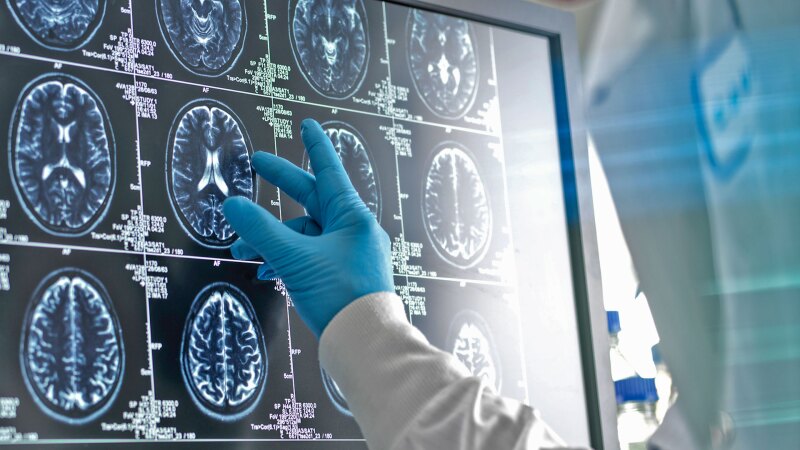About 280 million people around the world suffer from depression, and while they all struggle with persistent feelings of sadness, other symptoms can vary greatly: Some people with depression overeat, whereas others lack an appetite. Some have loud, angry outbursts; others become quiet and withdrawn. Some toss and turn all night; others sleep 10-plus hours a day.
The way depression manifests in an individual may seem quite variable, but scientists say there are actually brain-based reasons that explain the wide differences in symptoms. What’s more, they’ve been able to pinpoint specific brain circuits associated with a few common variants of depression symptoms—and are starting to use these findings to create targeted treatments.
That’s crucial, because a sizable portion of people with clinical depression—formally known as major depressive disorder—aren’t sufficiently helped by currently available therapies. In fact, nearly a third have what’s known as treatment-resistant depression, which means they’ve tried and failed at least two first-line treatments. Another third find that antidepressants are initially effective but become less effective or stop working after a while. That adds up to an enormous unmet need, one that Johnson & Johnson is determined to fill.
“Our commitment to mental health started more than 60 years ago,” says Peter Fang, Worldwide Vice President, Neuroscience, Global Commercial Strategy Organization, Johnson & Johnson Innovative Medicine. He notes that one of the first breakthroughs made by the namesake of the Janssen Pharmaceutical Companies of Johnson & Johnson (now known as Johnson & Johnson Innovative Medicine) was in psychiatry—Dr. Paul Janssen developed a revolutionary schizophrenia treatment. “Today we remain committed to making an impact in mental health around the world,” he adds.
What causes depression?
You may be surprised to learn that the exact cause of depression remains a mystery. While popular, the SSRI (short for selective serotonin reuptake inhibitor) class of antidepressant treatments works by increasing serotonin activity in the brain, yet limited evidence exists to indicate that depression is caused by a lack of this mood-regulating neurotransmitter.
“When companies first began marketing SSRIs, there was a lot of oversimplification, and the hypothesis that depression is generally caused by a serotonin deficiency was widely touted as fact,” says Wayne Drevets, M.D., Vice President, Disease Area Leader, Neuropsychiatry, Johnson & Johnson Innovative Medicine. “Nevertheless, enhancing serotonin transmission using serotonin reuptake inhibiting drugs clearly helps many patients who suffer from depression.”
In other words, “aspirin might get rid of your headache, but that doesn’t mean you developed a headache because of the absence of aspirin,” adds Bill Martin, Ph.D., Global Therapeutic Area Head, Neuroscience, Johnson & Johnson Innovative Medicine.
Advances in brain imaging over the past few decades have enabled us to understand the connection between symptoms and brain biology.
A combination of genetic, neurological, hormonal and environmental factors likely play a role in depression, but the precise combination is still murky and the specifics almost certainly vary from patient to patient. Dr. Drevets notes that there are likely subgroups of patients whose depression is driven, in part, by an imbalance in serotonin synthesis, release or receptor expression, and those people may be the ones most apt to respond to SSRIs.
As for the others? Johnson & Johnson scientists have uncovered some evidence about what’s happening in their brains and how to begin to treat them more effectively.
Better, more precise treatments
In order to be diagnosed with depression, an individual must have experienced a depressed mood and/or a loss of interest in all or most activities for at least two weeks. Conventional diagnostic criteria also require the presence of at least four other symptoms from a much longer list. Once diagnosed, people commonly receive a prescription for an SSRI or SNRI (serotonin-norepinephrine reuptake inhibitor, which works on the neurotransmitter norepinephrine in addition to serotonin). Although that one-size-fits-all approach works out some of the time, often it proves ineffective or only partially effective.
Johnson & Johnson scientists believe that sorting patients into subgroups based on the presence of specific symptoms may be the key to treating them optimally. “Advances in brain imaging over the past few decades have enabled us to understand the connection between symptoms and brain biology,” says Martin. “Now, when we see a certain symptom, we can map it to a specific circuitry problem, and we can develop treatments that block or augment the activity of that circuit.”
In 2020, the U.S. Food and Drug Administration approved the first and only drug that has been shown to reduce depression symptoms within 24 hours. But this medication is approved specifically for those who have treatment-resistant depression, as well as suicidal thoughts or behaviors.
Unlike SSRIs and SNRIs, the drug has its primary action on the glutamatergic neurotransmitter system, through which it is thought to help regenerate the connections between neurons (brain cells) that have withered during the chronic stress associated with depression—a problem that is more pronounced in people with treatment-resistant depression.
“The treatment-resistant group of patients is commonly more severely depressed and manifests more profound structural changes in the brain, including regional atrophy in brain structures that regulate mood and emotional behavior,” Dr. Drevets explains. “The nerve cells themselves don’t die, but the connections they form with other nerve cells shrivel.”
Johnson & Johnson is also developing two other medications that take a more precise approach to treating depression. One is targeted for patients who have depression as well as insomnia. It is believed to work by blocking a particular receptor in the brain, and by doing so reduces the functioning of an overactive brain circuit that regulates mood as well as sleep, says Martin.
In the future, psychiatry will look a lot more like oncology in terms of how we approach treatment. We’ll be able to use biomarkers and phenotypes to identify the right treatment for the right patient at the right time.
This oral therapy, which is currently in phase 3 clinical trials, is not simply an insomnia treatment, however. “We’ve demonstrated that it improves depression in these patients even when we control for insomnia,” says Martin. In other words, “they’re not getting better just because their sleep improves.”
The other Johnson & Johnson therapy in development is a pill designed to treat depression in people with anhedonia, meaning they don’t experience joy or pleasure from things they used to enjoy. “This is a core symptom for many people with depression, and it’s the one that is most resistant to change from existing therapies,” says Martin. “Even people who have improved with an SSRI often have residual anhedonia.”
Dr. Drevets adds that it’s quite common for someone taking an SSRI to have an improvement in “negative” depression symptoms—like sadness and worthlessness—yet not regain positive emotions like happiness and motivation. “These patients are considered responsive to SSRIs, but they’re not well,” he says. “They’re not back to their normal baseline.”
Anhedonia is believed to be, at least in part, related to a peptide in the brain that increases in activity in response to stress. The new Johnson & Johnson investigational treatment, also in phase 3 trials, “blocks a receptor that disrupts the circuit that regulates joy,” says Martin. By selectively blocking this receptor, the brain’s dopamine system—which plays a critical role in developing feelings of pleasure and reward—can resume normal functioning.
Moving toward greater personalization
Precision psychiatry is still in its infancy, though it’s expected to ultimately become the standard of care in psychiatry, as precision medicine has already in some other fields of medicine. While being able to sort patients into subtypes based on their symptoms represents significant progress, even more personalized approaches are on the horizon. “Today, we can stratify patients by asking about their symptoms, but tomorrow we might rely on blood-based biomarkers or even vocal intonations that could serve as speech biomarkers,” says Martin.
What that promises, says Fang, is a true transformation of the entire field. Eventually, patients seeking treatment won’t simply be told that they have depression; instead, they’ll learn what type of depression they have and be matched to the most appropriate treatment for it—which would eliminate much of the trial and error that’s so common today.
“In the future, psychiatry will look a lot more like oncology in terms of how we approach treatment,” adds Fang. “We’ll be able to use biomarkers and phenotypes to identify the right treatment for the right patient at the right time.”





